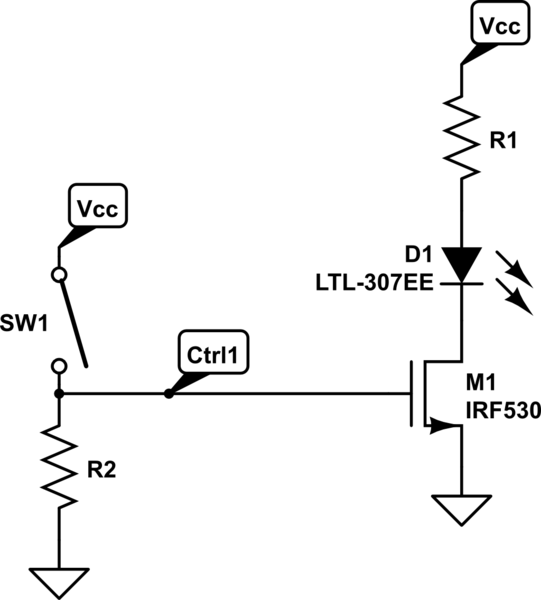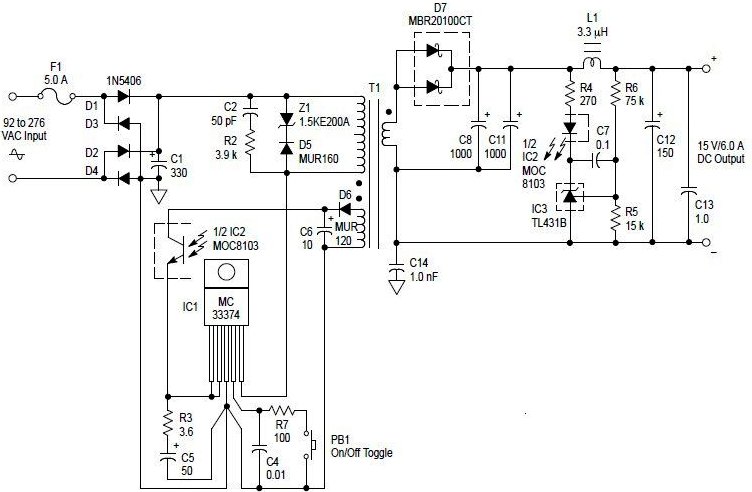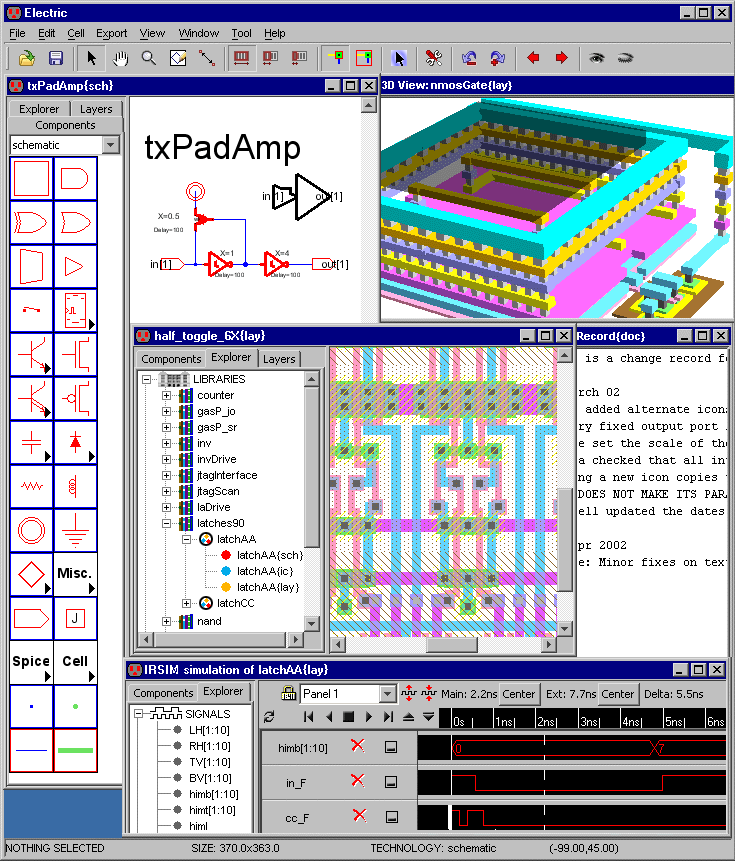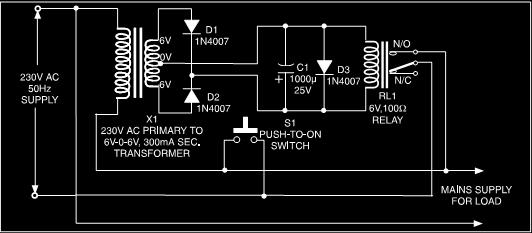
Site news archive - PCB Heaven
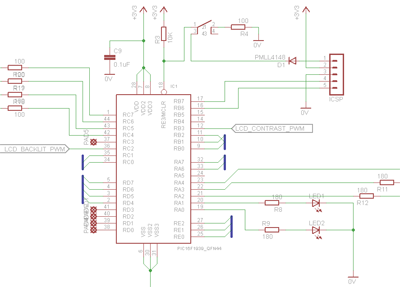
A simple remote-controlled autocue system was designed using materials salvaged from an old bin, including an outdated P4 laptop, a broken USB keyboard, and a piece of plexiglass. A foot switch is utilized to control the scrolling of the text displayed on the autocue screen. The first revision of the BJT Transistor Theory e-book has been released, correcting a major error in one image and rewriting the first chapter, which is available for free download and sharing. An aluminum piece was employed to mount a hot air gun on the carriage, enhancing the coupling of the stepper motor with a threaded rod, allowing for smooth rotation without vibrations. The motor is paired with an M6x1 threaded rod and nut, achieving a step calculation of 1mm per cycle (1mm per 200 motor steps = 0.1mm per 20 steps). The soldering reflow process is essential for QFN packages, requiring adherence to a manufacturer-provided reflow chart, which takes approximately 6 to 7 minutes and is challenging to follow manually. Therefore, an NC machine was constructed to automate the reflow process. The second page of the first circuit supporting the TEDIE Book includes measurements on a DC transistor load switch, with further calculations forthcoming. A previously uploaded video demonstrates a method for efficiently removing components from an old PCB, which has been misunderstood by some viewers. Salvaging parts offers more than just economic benefits. A forum member successfully utilized a simple AC dimmer circuit with a 555 timer to control a 3x1500W load for a professional automatic textile press. This project is a remake of an early electronic project created at age seven with the assistance of a grandfather, grandmother, and father. Due to the loss of the original pin detector, a remake was deemed necessary for historical purposes. An SMPS buck regulator was designed featuring a 2xAA NiMH battery trickle charger and power failure output, aimed at gaining experience with SMPS regulators and complementing a previously made boost regulator to create a functional power supply with a power failure indicator. Plans are underway to develop gadgets for camping trips, where electric power is scarce, relying instead on solar energy and batteries. An MCP1640 chip from Microchip was acquired to create an evaluation board for powering two high-power LEDs with heavily used batteries. A modification project for a Yamaha Crypton R includes replacing incandescent light bulbs with LEDs, adding a motorcycle alarm, and providing a 12V power outlet. During a repair of a double-sided edge banding machine, a defective Balluff inductive sensor was discovered in a multi-limit switch, which is no longer produced. The only solution was to order an expensive replacement, prompting a modification using a different inductive sensor. A simple method for calculating resistor values to drive LEDs is available for download, along with a PDF for creating a dial selector. On a Saturday, a spot lamp exploded, leading to the use of available 1W LEDs, an LM317, a large capacitor, and a 24VAC transformer for a quick fix.
The remote-controlled autocue system integrates several components to create a functional text display mechanism. The system uses a foot switch for user interaction, allowing the operator to control the flow of text seamlessly during presentations. The use of salvaged materials not only demonstrates resourcefulness but also promotes sustainability in electronics by repurposing old devices.
The stepper motor, coupled with the M6x1 threaded rod, provides precise control over the text scrolling mechanism. The calculated step resolution ensures that the text moves smoothly, enhancing readability for the audience. This meticulous design consideration highlights the importance of mechanical coupling in electronic systems.
The reflow process for QFN packages is critical in ensuring reliable soldering of components. The construction of an NC machine to automate this process reflects an understanding of the challenges associated with manual soldering techniques, particularly for complex packages. By adhering to the reflow chart, the machine guarantees consistent temperature profiles, which are essential for achieving optimal solder joints.
The additional projects mentioned, such as the SMPS buck regulator and modifications to the Yamaha Crypton R, exemplify the breadth of electronic applications. The SMPS regulator not only serves as a learning tool but also as a practical solution for portable power needs, particularly in outdoor settings where access to conventional power sources is limited.
In summary, the integration of various electronic components and systems showcases a blend of creativity and technical skill, providing valuable learning experiences and practical solutions in the field of electronics. Each project contributes to a broader understanding of electronic design principles, component functionality, and the importance of innovation in overcoming challenges.I designed the simplest remote-controlled autocue system possible with materials that i unburied from my old-and-busted bin, my old P4 laptop, a totally broken USB keyboard, a piece of plexiglass. A foot-switch controls the scrolling of the text in the autocue screen. The first revision of the BJT Transistor Theory e-book has been released. One ma jor error have been corrected in one image (thank you Nash). The first chapter has been re-written. Download and share for free. I used a piece of aluminum to mount the hot air gun on the carriage, and also i improved the coupling of the stepper motor with the threaded rod. The rod now revolves smoothly, there is no grinding sound from vibrations and the motor stays in position.
Heading towards an end, i mounted the stepper motor and the driving pair, an M6x1 threaded rod with an M6 nut will do the job perfectly and with an easily calculated step (1mm per cycle = 1mm per 200 motor steps = 0. 1mm per 20 steps) The soldering reflow process is usually the only way to go if QFN packages are used.
To properly reflow a QFN one has to follow a reflow chart provided by the manufacturer. The process takes some 6 to 7 minutes to fulfill, which is a lot for doing it by hand. Plus it is not easy for one to follow the temperature chart precisely. Therefore, i built this NC machine to do the reflow job automatically. I wrote the second page of the first circuit to support the TEDIE Book. In this page I take some measurements on the DC Transistor load switch. More calculations are coming up next. Some time ago I uploaded a video explaining how one can remove the various components from an old PCB fast and easy. It seems that many people misunderstood the purpose of this video. One gains more than just economical profit from salvaging parts. A forum member managed to use a simple test and educational AC Dimmer circuit using the 555 timer to control 3x1500Watts load for a professional Automatic Textile Press.
This is a remake of my very first electronic project. I made it when i was 7 with the help of my grandfather, the mop of my grandmother, the flash from the camera of my father. This was the kickstart for me in the world of electronics. Since the original pin detector is lost, i thought that i should make a remake for the history. I designed an SMPS buck regulator with 2xAA NiMh battery trickle charger and power failure output. I designed this circuit mainly to gain experience with SMPS regulators, and to pair it with a boost regulator that i made some time ago and make a nice power supply with power failure light!
I love camping, and i plan to make some gadgets for my summer holidays in nature. Electric power is something that you cannot find in abundance when you camp at the sea side, but sun and batteries are. So, i got this MCP1640 chip from Microchip to make an evaluation board and see what this tiny thing can do, by powering 2 high power LEDs with 2 heavily used batteries.
Modding Yamaha Crypton R. A very instresting project that icludes the replacing of all Incandescent light bulbs to leds, a motorcycle alarm, and a power outlet for providing 12v supply. I was called to repair a double-sided edge banding machine and discovered that the Balluff inductive sensor of a multi-limit switch was defective.
Balluff does not produce these sensors any more, so the only possible solution was to order the complete multi-switch. The cost was ridiculously high. So instead, i modded the switch and used another inductive sensor. Here is a very simple way to "calculate" the resistor values to drive your LEDs - Download and print the PDF that i provide, follow the instructions and make your own dial selector within a few minutes.
It is Saturday and my spot-lamp just exploded. I do not have a fluorescent U-lamp to change, but i do have some 1W LEDs in stock, an LM317, a big capacitor and a 24VAC transformer. Axe in hand, hack has fun! I ran a 🔗 External reference
The remote-controlled autocue system integrates several components to create a functional text display mechanism. The system uses a foot switch for user interaction, allowing the operator to control the flow of text seamlessly during presentations. The use of salvaged materials not only demonstrates resourcefulness but also promotes sustainability in electronics by repurposing old devices.
The stepper motor, coupled with the M6x1 threaded rod, provides precise control over the text scrolling mechanism. The calculated step resolution ensures that the text moves smoothly, enhancing readability for the audience. This meticulous design consideration highlights the importance of mechanical coupling in electronic systems.
The reflow process for QFN packages is critical in ensuring reliable soldering of components. The construction of an NC machine to automate this process reflects an understanding of the challenges associated with manual soldering techniques, particularly for complex packages. By adhering to the reflow chart, the machine guarantees consistent temperature profiles, which are essential for achieving optimal solder joints.
The additional projects mentioned, such as the SMPS buck regulator and modifications to the Yamaha Crypton R, exemplify the breadth of electronic applications. The SMPS regulator not only serves as a learning tool but also as a practical solution for portable power needs, particularly in outdoor settings where access to conventional power sources is limited.
In summary, the integration of various electronic components and systems showcases a blend of creativity and technical skill, providing valuable learning experiences and practical solutions in the field of electronics. Each project contributes to a broader understanding of electronic design principles, component functionality, and the importance of innovation in overcoming challenges.I designed the simplest remote-controlled autocue system possible with materials that i unburied from my old-and-busted bin, my old P4 laptop, a totally broken USB keyboard, a piece of plexiglass. A foot-switch controls the scrolling of the text in the autocue screen. The first revision of the BJT Transistor Theory e-book has been released. One ma jor error have been corrected in one image (thank you Nash). The first chapter has been re-written. Download and share for free. I used a piece of aluminum to mount the hot air gun on the carriage, and also i improved the coupling of the stepper motor with the threaded rod. The rod now revolves smoothly, there is no grinding sound from vibrations and the motor stays in position.
Heading towards an end, i mounted the stepper motor and the driving pair, an M6x1 threaded rod with an M6 nut will do the job perfectly and with an easily calculated step (1mm per cycle = 1mm per 200 motor steps = 0. 1mm per 20 steps) The soldering reflow process is usually the only way to go if QFN packages are used.
To properly reflow a QFN one has to follow a reflow chart provided by the manufacturer. The process takes some 6 to 7 minutes to fulfill, which is a lot for doing it by hand. Plus it is not easy for one to follow the temperature chart precisely. Therefore, i built this NC machine to do the reflow job automatically. I wrote the second page of the first circuit to support the TEDIE Book. In this page I take some measurements on the DC Transistor load switch. More calculations are coming up next. Some time ago I uploaded a video explaining how one can remove the various components from an old PCB fast and easy. It seems that many people misunderstood the purpose of this video. One gains more than just economical profit from salvaging parts. A forum member managed to use a simple test and educational AC Dimmer circuit using the 555 timer to control 3x1500Watts load for a professional Automatic Textile Press.
This is a remake of my very first electronic project. I made it when i was 7 with the help of my grandfather, the mop of my grandmother, the flash from the camera of my father. This was the kickstart for me in the world of electronics. Since the original pin detector is lost, i thought that i should make a remake for the history. I designed an SMPS buck regulator with 2xAA NiMh battery trickle charger and power failure output. I designed this circuit mainly to gain experience with SMPS regulators, and to pair it with a boost regulator that i made some time ago and make a nice power supply with power failure light!
I love camping, and i plan to make some gadgets for my summer holidays in nature. Electric power is something that you cannot find in abundance when you camp at the sea side, but sun and batteries are. So, i got this MCP1640 chip from Microchip to make an evaluation board and see what this tiny thing can do, by powering 2 high power LEDs with 2 heavily used batteries.
Modding Yamaha Crypton R. A very instresting project that icludes the replacing of all Incandescent light bulbs to leds, a motorcycle alarm, and a power outlet for providing 12v supply. I was called to repair a double-sided edge banding machine and discovered that the Balluff inductive sensor of a multi-limit switch was defective.
Balluff does not produce these sensors any more, so the only possible solution was to order the complete multi-switch. The cost was ridiculously high. So instead, i modded the switch and used another inductive sensor. Here is a very simple way to "calculate" the resistor values to drive your LEDs - Download and print the PDF that i provide, follow the instructions and make your own dial selector within a few minutes.
It is Saturday and my spot-lamp just exploded. I do not have a fluorescent U-lamp to change, but i do have some 1W LEDs in stock, an LM317, a big capacitor and a 24VAC transformer. Axe in hand, hack has fun! I ran a 🔗 External reference

